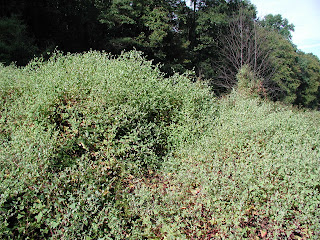I thought I
would share this with my readers. Bill
Cook from Michigan State posted these.
There may be others you have heard, see what you think. Feel free to
share. One that I have heard quite often
is, “We will just cut the large old trees to let the smaller younger trees
grow.” Unfortunately, those smaller
trees are often the same age and completely different species than the big
trees.
By Bill
Cook, Michigan State University Extension
April 2,
2018
Forests,
forestry and the forest industry are among the most environmentally friendly of
human activities, contrary to common perspectives. Our popular culture seems to
perpetuate many incorrect assumptions and perceptions about forests and how
humans depend upon forests. Do not believe everything you read. Look it up and
learn, it can end up being pretty fun stuff!
1. Trees provide the air we breathe.
Most of the
Earth’s fresh oxygen is produced from the oceans, which makes sense when you
understand that three-quarters of the Earths’ surface is covered with water.
For terrestrial systems, non-forest biomes are the most common. So, oxygen from
trees? Meh. Okay, they produce some, but it is not a particularly high value
attributable to trees or forests.
2. We should plant two trees for every one
we harvest.
In the Lake
States, planting is typically unnecessary. Our forest management systems are
tailored to the various forest types to create environmental conditions that
encourage natural regeneration. This management is quite successful. So, why
plant a few trees when nature will successfully produce billions? This said,
there are circumstances where tree planting is needed and useful.
3. A tree grows one ring per year.
If a tree
grew only one ring, how could you tell where last year’s ring ended and the
next year’s ring began? In fact, our northern temperate trees grow two annual
rings each year. The wider, light-colored ring grows in the springtime,
followed by the narrower, dark colored ring in the summertime. Then, the tree
stops growing wood for about six months.
4. Forests are disappearing.
This is not
true in Michigan or across the Lake States, although it is true in some regions
around the world. As of 2017, Michigan has more acres of forestland than any
time since the 1930s, when statistical forest inventories began. Now, if you
live in an urban area and see sprawl gobbling up the countryside, it might be
easy to get this impression. However, statewide, we now have a bit over 20
million acres of forest, and that covers a little over half the state.
5. Clearcutting is deforestation.
Deforestation,
by definition, is a land use change from forest to something else. The
overwhelming amount of deforestation is for agriculture, and then, secondly,
for building human infrastructure. Clearcutting is a forest regeneration
practice designed to stimulate the reproduction of sun-loving tree species,
such as the aspens, red pine, jack pine and others. Natural clearcutting
happens through wildfire, windstorms, insect and disease outbreaks and similar
events. While clearcutting is not quite exactly the same thing, it’s far more
benign than natural occurrences.
6. Planting a tree will save the planet.
This is a
popular promotional campaign and has some value in raising awareness, but in
ecological terms it is nonsense. Even if every Michigander planted a thousand
trees every year, that amount would not come close to annual natural
regeneration. However, planting trees does have strategic value in filling-in
where nature missed a beat, to change forest type compositions, or to achieve a
visual quality objective at a residence or in a city. So, planting trees is a
great thing, it is just not going to save the planet.
7. Mother nature knows best.
Nature knows
nothing. It is not sentient. Benign neglect is not a fruitful strategy. The
predictable paths of natural succession lead to places most people are not
going to be happy with. First, the forest legacy following the historic logging
era left forests in an unnatural condition, which is the forest that we see
today. Second, ecological forest processes alone are unlikely to meet all the
demands that society places upon forests. Third, forest health challenges and
exotic species place additional pressures on forests. The solution to these
problems is active forest management. We don’t manage forests for the forests’
sake. We manage forests for people, by working with natural processes.
8. Timber harvest destroys wildlife
habitat.
Harvest,
natural disturbance or forest succession creates habitat changes. These changes
benefit some species and do not benefit others. Therefore, any particular
timber harvest will have wildlife winners and losers. The same is true without
the harvest. More likely, critics of timber harvest react to the change in
visual quality, which is an especially poor measure of ecological integrity.
9. Government owns most of the forest.
Nearly
two-thirds of the Michigan forest is privately owned. Of that, families own
nearly three-quarters. The State of Michigan owns about 21 percent and the
federal government owns about 17 percent. Ownership has a huge impact on how a
forest is managed. However, regardless of ownership, all forests provide
benefits to everyone.
10. Forest industry is a destructive,
extractive industry.
It is
counter-intuitive to many, but the forest industry provides the financial
incentive for forest management. No markets leads to no management. With an
unmanaged forest, there is a road of troubles. Additionally, there is no
greener industry. Thousands of daily products, made from the most
environmentally friendly raw material at our disposal, come from forests.
Forest products also include clean water and a diversity of wildlife habitat.
In contrast to the myth, the forest industry supports a wide range of goods and
services, including a healthier environment. Wood use is not a choice, it is
essential to our survival. Every U.S. resident uses an average of three to four
pounds of wood every day.






